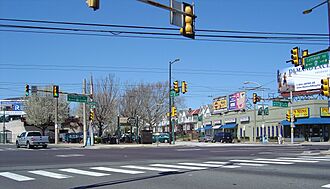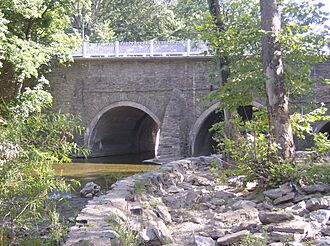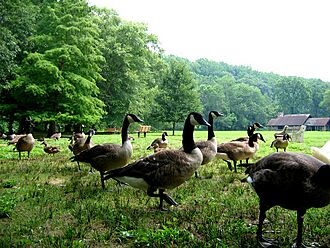Northeast Philadelphia facts for kids
Quick facts for kids
Northeast Philadelphia
|
|
|---|---|
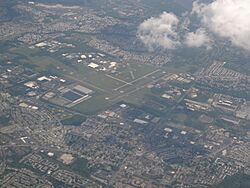
Aerial view around the Northeast Philadelphia Airport
|
|

Map of Philadelphia County with Northeast highlighted, which contains the lower Northeast neighborhood. Click for larger image.
|
|
| Country | |
| State | |
| County | |
| City | |
| Area | |
| • Total | 50.8 sq mi (132 km2) |
| Population | |
| • Total | 528,810 |
| • Density | 10,455/sq mi (4,037/km2) |
| ZIP Code |
19111, 19114, 19115, 19116, 19124, 19135, 19136, 19149, 19152, 19154
|
Northeast Philadelphia, often called Northeast Philly or the Northeast, is a big part of Philadelphia, Pennsylvania. In 2010, over 528,000 people lived here. It's known for having many different groups of people.
You'll find families from all over the world. This includes people with Polish, German, Jewish, Russian, African American, Brazilian, Puerto Rican, Dominican, Guatemalan, Ukrainian, Indian, Chinese, Irish, and Vietnamese backgrounds.
Contents
- What is the Geography of Northeast Philadelphia?
- When Did Northeast Philadelphia Begin?
- Who Lives in Northeast Philadelphia?
- Public Safety in Northeast Philadelphia
- What Can You Do in Northeast Philadelphia?
- News and Media in Northeast Philadelphia
- Recreation and Parks in Northeast Philadelphia
- How to Get Around Northeast Philadelphia?
- Famous People from Northeast Philadelphia
What is the Geography of Northeast Philadelphia?
Northeast Philadelphia is a large area. The city planners divide it into two main parts. These are called the Lower Northeast and the Far Northeast. Their names show how far they are from Center City. People often use the term "Far Northeast." The Pennypack Creek usually marks the border between these two sections.
The Northeast is bordered by the Delaware River to the east. Bucks County is to the north. Montgomery County is to the west. Its southern border is usually considered to be Frankford/Tacony Creek or Adams Avenue.
Neighborhoods in the Lower Northeast
- Burholme
- Castor Garden
- Crescentville
- Fox Chase
- Frankford
- Holmesburg
- Lawncrest
- Lawndale
- Lexington Park
- Mayfair
- Northwood
- Oxford Circle
- Rhawnhurst
- Ryers
- Tacony
- Wissinoming
- Bridesburg
Neighborhoods in the Far Northeast
- Academy Gardens
- Ashton-Woodenbridge
- Bustleton
- Byberry
- Crestmont Farms
- Holme Circle
- Krewstown
- Millbrook
- Modena Park
- Morrell Park
- Normandy
- Parkwood
- Pennypack
- Pine Valley
- Somerton
- Torresdale
- Upper Holmesburg
- Winchester Park
When Did Northeast Philadelphia Begin?
Early European Settlements
The first Europeans to settle in the Northeast were Swedish farmers. They came when the area was part of the New Sweden colony. Later, English Quakers arrived. One of them was Thomas Holme, who helped start William Penn's Pennsylvania colony in the late 1680s.
For many years, Northeast Philadelphia was a collection of small towns and farms. These were part of Philadelphia County but not the City of Philadelphia itself. Before it joined the city, the Northeast had several townships like Byberry and Lower Dublin. It also had more urban towns like Bridesburg and Frankford.
Growth of Industry and Farming
Most of the land in the Northeast was used for farming. But the many creeks and its closeness to Philadelphia made it good for factories. The first factory in the Northeast was the Rowland Shovel Works. It opened on the Pennypack Creek in 1802. This factory made the first shovel in the United States.
More factories and mills were built along the Pennypack and Frankford Creeks. You can still see parts of the old mill races and dams today. One very famous factory was the Disston Saw Works in Tacony. It was started by Henry Disston, and his saw blades were known worldwide.
Joining the City and Population Growth
In 1854, Philadelphia County became part of the city. Even after this, the Northeast kept its rural feel for a while. The crowded city style of housing hadn't reached it yet.
In the early 1900s, more factories were built. This led to more people moving to the Northeast. New transportation, like the Market-Frankford Line train and major roads like the Roosevelt Boulevard, also helped. Many middle-class families moved to the lower part of the Northeast.
From the 1920s to the 1930s, many row homes were built. These homes often had small front lawns. This gave the Northeast a "garden suburb" look. This made it feel less crowded than other parts of the city. Much of this building happened east of Roosevelt Boulevard and in Oxford Circle.
Growth After World War II
After World War II, many new families moved to the Northeast. They used benefits from the GI Bill to buy homes. This led to a "baby boom" in the area. These new residents were often Jewish or Catholic families. They came from Irish, Italian, Polish, and German Americans backgrounds.
They helped develop the rest of the region. This included filling in empty areas and building up the previously rural Far Northeast. As older parts of Philadelphia lost young families, the Northeast's schools became very full. This meant more schools, libraries, and shops were needed.
From 1945 to the 1970s, many older, industrial cities faced challenges. Philadelphia saw its population, factories, and jobs decrease in some areas. But the Northeast grew with many middle-class families. Over time, many young people from the Northeast moved to the suburbs. This made space for new families from Latino, African American, and Asian backgrounds.
A Unique Identity
In the 1980s, the Northeast started to feel different from the rest of Philadelphia. People in the Northeast were often unhappy with high city taxes. They felt they didn't get enough services for their money. This led to a movement to make the Northeast a separate county called Liberty County. State Senator Frank "Hank" Salvatore led this effort. However, the idea did not become a reality.
As Philadelphia's economy improved, and a popular mayor, Ed Rendell, was elected, the idea of separating faded. Today, the Northeast has a good mix of different cultures. It is a stable part of the city. Like many urban areas, it has seen some factories close. But during the early 2000s, new homes were built, and existing home prices went up.
Who Lives in Northeast Philadelphia?
In 2010, about 432,073 people lived in Northeast Philadelphia.
People from Different Backgrounds
- White (not Hispanic): 58.3%
- Black (not Hispanic): 18.0%
- Hispanic or Latino: 13.9%
- Asian: 7.3%
- Mixed or Other: 2.5%
- Native American: 1.8%
Irish Americans
Many Irish immigrants came to Philadelphia because of the Irish Famine. Today, Irish Americans make up a large part of Philadelphia's population. Many of them live in Northeast Philadelphia, especially in neighborhoods like Kensington, Fishtown, and Mayfair.
Public Safety in Northeast Philadelphia
The Philadelphia Police Department helps keep the Northeast safe. They have four police districts in the area. These include the 7th and 8th districts in the Far Northeast. The 2nd and 15th districts are in the Near Northeast.
What Can You Do in Northeast Philadelphia?
Northeast Philadelphia has Philadelphia Mills, a large shopping mall. It was built where the Liberty Bell Park Racetrack used to be. It's one of the most popular places to visit in Pennsylvania. The southern parts of the Northeast also have nice shopping streets with stores and restaurants, like Castor Avenue. Other big shopping centers include the Cottman-Bustleton Center and the Roosevelt Mall.
The Northeast also has two well-known medical centers: Friends Hospital and Fox Chase Cancer Center.
Education in Northeast Philadelphia
The first school in the Northeast was started in 1723 by Silas Crispin. The Northeast is also home to Fox Chase Farm. This is an educational farm and the only working farm left in Philadelphia.
Colleges and Universities
Holy Family University has its main campus in Northeast Philadelphia. It was founded in 1954 and has over two thousand students.
Schools for Kids
The School District of Philadelphia runs public schools in the area. High schools include Northeast, Abraham Lincoln, Samuel S. Fels High School, Frankford, George Washington, and Swenson. There are also several publicly funded charter high schools. These include Philadelphia Academy, MaST, Franklin Towne, and Maritime Academy Charter High School. The Northeast also has a public magnet school called The Arts Academy at Benjamin Rush.
The Roman Catholic Archdiocese of Philadelphia operates Catholic schools. Catholic high schools in Northeast Philadelphia include St. Hubert Catholic High School for Girls, Father Judge, and Archbishop Ryan. Some Catholic high schools, like Cardinal Dougherty and Northeast Catholic, have closed due to fewer students. Nazareth Academy is another Catholic high school run by the Sisters of the Holy Family of Nazareth.
News and Media in Northeast Philadelphia
The Northeast Times is a free weekly newspaper. It is given out all over the Northeast. Two citywide newspapers, The Philadelphia Inquirer and Philadelphia Daily News, also cover news from the Northeast.
Recreation and Parks in Northeast Philadelphia
A major natural area in Northeast Philadelphia is Pennypack Creek. It flows through Pennypack Park. The park has 1,600 acres (6.5 km2) of woods. It's like a natural escape in the middle of the city. The park has the oldest stone arch bridge still in use in the United States. It was built in 1697 on what is now Frankford Avenue. The Northeast also has many playgrounds and smaller parks, like Burholme Park.
How to Get Around Northeast Philadelphia?
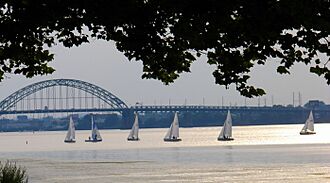
The main highways in the Northeast are Interstate 95 and Roosevelt Boulevard (US 1). Other important roads include Cottman Avenue (PA 73), Frankford Avenue (US 13), and Woodhaven Road (PA 63).
The Tacony-Palmyra Bridge connects the Tacony part of the city to Palmyra, New Jersey. It's the only bridge over the Delaware River in Philadelphia not run by the Delaware River Port Authority, so it has a cheaper toll.
The Northeast is also served by SEPTA's Market-Frankford Line. People often call it "the El" because parts of the train line are elevated above the streets. The end of the line is at the Frankford Transportation Center. Three commuter rail lines also serve the Northeast. There's even a proposed extension of the Broad Street Line along Roosevelt Boulevard. Many SEPTA bus routes and all three of its trackless trolley routes run through the Northeast.
One of Philadelphia's two airports, Northeast Philadelphia Airport (PNE), is in this area. PNE is the sixth busiest airport in Pennsylvania.
Famous People from Northeast Philadelphia
- Eddie Alvarez, a champion in mixed martial arts
- St. Katherine Drexel, a Roman Catholic Saint
- Rich Gannon, a former NFL quarterback and MVP
- Chris Matthews, a political TV commentator
- Andrea McArdle, a singer and actress
- Bob Saget, a well-known actor and comedian
- Sylvester Stallone, a famous actor




